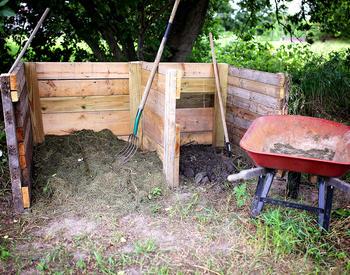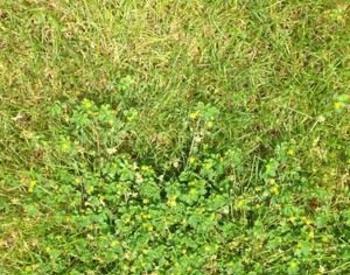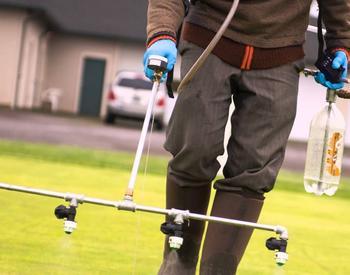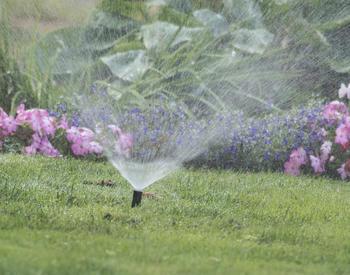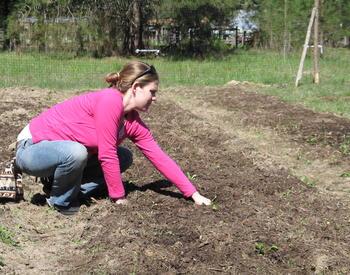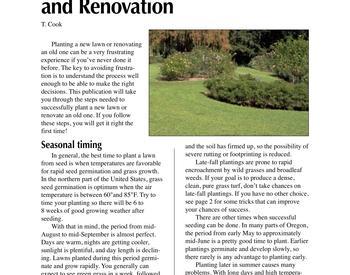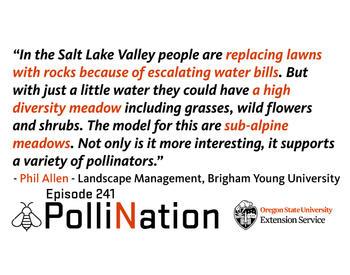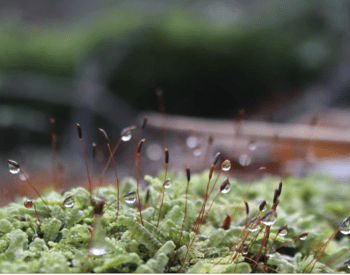Love your grass lawn but want to make your landscape more climate-friendly? Lawns might get a bad rap but provide benefits such as play space for kids and pets, erosion control and allowing line-of-sight at intersections. They are also a low-cost, easy-maintenance ground cover. There are thoughtful ways to keep a lawn as part of your landscape while balancing climate change concerns.
Before we dive in, let’s briefly discuss some of the environmental benefits of having a grass lawn.
Lawns help manage stormwater runoff
Many areas of Oregon are predicted to experience more intense rainstorms due to the changing climate (See the Oregon Climate Assessment’s chapter on flooding). Compared to impermeable surfaces (like concrete), lawns can play an important role in managing the runoff from these severe storms. Lawns, grass paver drives and walkways, and other permeable surfaces can slow the horizontal movement of water. This allows time for the rain to infiltrate down into the soil. This will reduce the flow into the stormwater system and help mitigate flooding.
Lawns help reduce urban heat
Bare soil and impervious surfaces (like asphalt and concrete) increase temperatures in comparison to surfaces covered in plants. Research has also shown that actively growing turfgrass will reduce daytime temperatures compared to bare soil, asphalt and artificial turf on a hot summer day. On average, turfgrass is 4°C cooler than urban surfaces not covered with turf and as much as 39°C cooler than synthetic turf on a hot day (Brosnan et al., 2020).
But what about climate change? Are grass lawns a friend or foe?
Climate change is occurring because an excessive amount of the gas carbon dioxide (CO2) is accumulating in the atmosphere. This extra CO2 acts like a greenhouse or blanket. The result is that excess heat is trapped close to the earth. This is causing changes to our climate. We are seeing increases in the average temperatures, rainfall, severe weather events, etc.
All green plants have the potential to absorb or capture this extra carbon from the atmosphere through photosynthesis. (Plants absorb CO2 and use water and sunlight to make their food. This is called photosynthesis.) This process of pulling carbon out of the atmosphere and back down into a plant is a type of carbon sequestration.
So, where do lawns come in?
Unlike an annual vegetable or flower garden, lawns are densely planted and perennial. They also cover the soil year-round in the Pacific Northwest. A lawn’s long growing season means a greater potential for pulling carbon from the air into the grass blades and root system.
It sounds like lawns are a great choice to plant to pull extra carbon out of the atmosphere, right? Not so fast! Lawns are a surprisingly complicated ecosystem (and so is the carbon sequestration process). So, it isn’t easy to make broad generalizations. Lawns take in carbon from the air and temporarily store it in the grass blades and the roots. But, some of that carbon is moved back into the atmosphere by soil microorganisms (like bacteria) that break down roots and thatch (accumulated leaves, stolons, and rhizomes on the soil surface).
Oregon State University’s Turf Management Program researchers are studying how to best balance this. Studies show that mowing, fertilizing and irrigating can increase the amount of carbon moving into the grass plants (by boosting photosynthesis) and soil. We also know that some cultural practices encourage soil microbes to break down organic matter (releasing carbon back into the atmosphere).
OSU researchers are currently determining the optimum lawn management practices to have lawns be at least a "net carbon sink." This means having more carbon stored in the grass plants and the soil than is released by soil microbe decay.
Here are suggestions based on what we know so far:
Tips for moving toward a more climate-friendly and healthy lawn
Mindful mowing & management
Select the optimum mowing height
Lawns managed at a higher mowing height have greater shoot biomass. However, a lower mowing height produces greater lawn density by stimulating lateral growth. Recent research at OSU in Corvallis suggests that a 2-inch mowing height is optimum for lawn health, broadleaf weed prevention and carbon sequestration (Braithwaite et al., 2021; Wang et al., 2021). Mowing lower than 2 inches will open the opportunity for weeds to move in. While mowing higher than 2 inches may reduce carbon sequestration because the density of the lawn will decrease. (Fewer grass plants per square foot. This means fewer plants absorbing carbon.)
Keep grass clippings in place
Skip the bag or use a mulching mower to return grass clippings to the lawn. Mulching mowers have special blades to chop the grass finely. Other mowers can be used without the collection bag in place. Use a rake to separate any large clumps of clippings to avoid smothering the lawn. This recycles nutrients like nitrogen, potassium and phosphorous into the lawn and reduces fertilizer needs. Research shows that bagging and removing grass clippings will remove around half the nitrogen applied in a year (Grégoire et al., 2022). For instance, if 4 lbs of nitrogen per 1,000 sq ft were applied in a year, 2 lbs of nitrogen per 1,000 sq ft were removed by bagging clippings during mowing.
Build the soil
Adding compost can help build the soil. Spread a one-quarter-inch layer over an existing lawn in the spring or fall and rake in. The quarter-inch compost layer will provide approximately 2 lbs of N per 1,000 sq ft. Therefore, two applications at this rate would provide 4 lbs N per 1,000 sq ft annually (annually fertilization rates should be 2 to 4 lbs N per 1,000 sq ft annually).
Skip the emissions
Switch to electric-powered mowers, edgers, string trimmers, blowers and other equipment. Gas-powered lawn equipment runs on petroleum-based fuels. These emit carbon and other pollutants into the air. In some cases, the emissions from older gas-powered equipment can be many times higher than a car. Electric-powered equipment is readily available as either plug-in or battery-powered units. Manual reel mowers are another lower-cost option that only use human power to cut the lawn using sharp rotating blades.
Apply fertilizer thoughtfully
- To reduce your carbon footprint, consider applying organic fertilizers. Great examples include Milorganite, BioTurf and Dr. Earth. Organic fertilizers like this are naturally slow-release, meaning heavier, infrequent applications are possible. Two applications per year, once in the spring and once in the fall, at 1 to 2 lbs N per 1,000 sq ft (totaling 2 to 4 lbs N per 1,000 sq ft, respectively), should be adequate.
- If you are using synthetic fertilizer, pick a product with a low concentration of phosphorus; a 10:1 nitrogen to phosphorus ratio is suggested. Research has shown that lawns require a relatively low amount of phosphorus (Waddington et al., 2021). Excess phosphorus will accelerate eutrophication (death of animal life in a waterway). A slow-release synthetic fertilizer will also reduce leaching associated with quick-release nitrogen sources and allow for heavier, infrequent applications.
- Adding clover to your lawn can also negate nitrogen fertilizer requirements. Clovers and other legumes can fix (generate) nitrogen from the atmosphere. Adding these elements to create an “eco-lawn” has become quite fashionable and will resolve concerns associated with the carbon emissions produced during fertilizer manufacturing and delivery.
Use water wisely
- If you can tolerate a brown lawn in the summer, let it go dormant by not watering. Keep in mind that unirrigated lawns are more susceptible to broadleaf weed invasion and will require some maintenance in the fall after the hot, dry summer. Dormant lawns are also generally carbon-neutral. The lawn isn’t growing and taking in carbon, but the soil microbes also aren’t active and releasing carbon.
- While the historical trend has been deep and infrequent irrigation, recent research in western Oregon has shown that lighter, more frequent irrigation will provide a healthier lawn while using less water (Blankenship et al., 2020; Cain et al., 2021). More specifically, around one-quarter inch applied four times per week, totaling one inch per week, will result in a greener, healthier lawn with fewer weeds than a lawn that receives one inch applied in a single application. Reducing the amount of irrigation water will also decrease the microbial activity of the soil and reduce carbon emissions.
Replace your water-hungry lawn
- Tall fescue is generally a drought-tolerant, cool-season grass that can retain some green color during summertime without irrigation. In contrast, fine fescues can survive with little to no water by going into dormancy.
- Research in the Willamette Valley has shown that one-half inch per week is adequate for tall fescue while one inch per week is required for perennial ryegrass. In eastern and central Oregon, tall fescue will require more irrigation (roughly one inch per week) but less than other grass species in this environment (Blankenship et al., 2020).
- Common yarrow (Achillea millefolium) is a typical component used in Oregon eco-lawn plantings. A mixed planting of common yarrow and grass will keep the lawns looking green longer into the summer months without any irrigation. If monthly irrigation is applied (one-half to one inch once a month), the lawn may stay green all summer. Common yarrow and other eco-lawn seeds can be purchased from specialty seed companies online. Eco-lawns can be planted by overseeding into an existing lawn or during a complete renovation.
- Other low-growing, non-grass ground covers include creeping thyme, creeping mint, low-growing chamomile or even moss. Match the ground cover to the amount of sunlight and moisture the site receives.
Rethink weed management
Build your tolerance of weeds
Not every weed needs to be removed to have an attractive, easy-to-manage lawn. Weeds can even help increase biodiversity in your yard by providing food sources for different insects. Flowering weeds can provide support for pollinators.
Use herbicides wisely, if at all
The emissions released from the production of synthetic herbicides contribute to climate change. When possible, mow before the seed sets to avoid spread or use physical removal for weed management. If a chemical herbicide is warranted, choose from the list of low-impact herbicides published on the Oregon School IPM Program website.
Resources
- Choose a lawn mower that fits your needs
- Oregon Climate Assessment
- Read about grass pavers and other permeable surfaces.
- National Emissions from Lawn and Garden Equipment, 2011. Environmental Protection Agency report.
- Practical Lawn Care for Western Oregon
- Irrigation Rates and Frequencies for Western and Eastern Oregon Turfgrass
- Low-impact pesticides list from the OSU School IPM Program website
References
- Braithwaite, E., T. Stock and A. Kowalewski. 2021. Integrated Pest Management Effects on Weed Populations Managed Without Herbicides in the Pacific Northwest. Int Turfgrass Soc Res J.
- Brosnan, J.T, A. Chandra, R.E. Gaussoin, A. Kowalewski, B. Leinauer, F.S. Rossi, D.J. Soldat, J.C. Stier and J.B. Unruh. 2020. Justification for Continued Management of Turfgrass During Economic Contraction. Agricultural & Environmental Letters.
- Blankenship, T., J. Lambrinos, L. Brilman, A. Kowalewski, R. Golembiewski, B. McDonald, C. Mattox* and M. Dumelle. 2020. Water Requirements Influenced by Turfgrass Species and Mowing Height in Western Oregon. Crop Forage and Turfgrass Management. DOI:10.1002/cft2.20020.
- Cain, A., E. Braithwaite, B. McDonald, A. Kowalewski, and M. Elmore. 2021. Irrigation Frequencies and Reference Evapotranspiration Replacement Effecting Annual Bluegrass Populations in Western Oregon. Int Turfgrass Soc Res J.
- Grégoire, G., R. Benjannet, and Y. Desjardins. 2022. Science of the Total Environment. Contribution of grass clippings to turfgrass fertilization and soil water content under four nitrogen levels
- Wang, R., C. Mattox, E. Braithwaite, C.L Phillips, T. Stock and A.R. Kowalewski. 2021. Mowing, Fertilization, and Irrigation Affects the Ability of Cool-Season Turfgrass System to Assimilate CO2. 2021 ASA, CSSA, SSSA International Annual Meeting.



